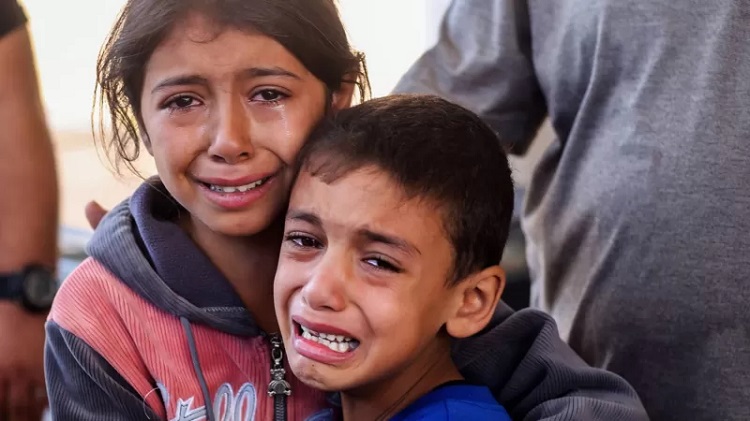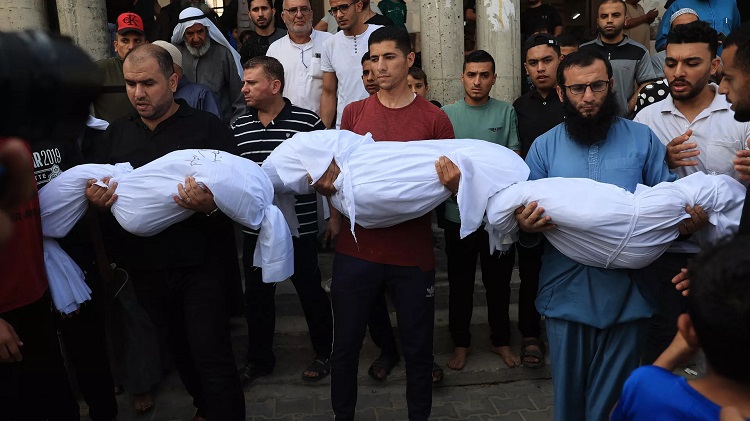The number of children in Gaza affected by the conflict continues to grow, with more than 3,000 children killed by bombing, thousands more missing or captured, and more than a million children without water, food and other basic products.

Gaza has become a “cemetery” for children, a UNICEF official said on Tuesday, noting that more than 3,400 children have died in bombing and that more than a million children face serious shortages of basic items and lifelong trauma.
For his part, United Nations humanitarian aid coordination official Martin Griffiths, who visited Israel and the occupied Palestinian territories a few days ago, spoke by phone with Gaza families from East Jerusalem, and said that what they have suffered since the beginning of the Israeli retaliation is the deadly attacks launched by Hamas on October 7. October was “beyond devastating.”
“When an eight-year-old girl tells you she doesn’t want to die, it’s hard not to feel helpless,” she wrote on the social media platform X, formerly known as Twitter.
Children buried under the rubble
“According to reports, more than 3,450 children have died so far. It is astonishing that this number is increasing dramatically every day. Gaza has become a cemetery for children. It is… Hell for everyone.”
The agency added that another thousand children were reported missing and could be trapped or dead under the rubble awaiting rescue or recovery. Office for the Coordination of Humanitarian Affairs of the United Nations (OCHA).
Its spokesman, Jens Laerke, said: “It is almost unbearable to think of children buried under the rubble with so little chance of being extricated.”
Decades of trauma ahead
“The threats go beyond bombs and mortar shells,” said UNICEF’s James Elder. Child deaths due to drought constitute an “increasing threat” in the Strip, as water production in Gaza is 5% of the required volume due to desalination plants stopping work, damage, or fuel shortages.
He added that when the fighting finally stops, the costs to children “will be felt for decades” due to the terrible traumas faced by survivors.

Elder cited the example of the four-year-old daughter of a UNICEF staff member in Gaza, who began self-harming due to daily stress and fear, while her mother told colleagues: “I can’t think about my children’s mental health, I need to keep them alive first.”
A humanitarian ceasefire is essential
Elder reiterated calls “on behalf of the 1.1 million children in Gaza living in this nightmare”, for an immediate humanitarian ceasefire and the opening of all access points for sustained humanitarian access. “If we had a 72-hour ceasefire, this would mean a thousand children would be safe again this time.”
The families of the hostages live in agony
Also on Monday, Griffiths met in Jerusalem with relatives of some of the more than 230 hostages held in Gaza since October 7. It is believed that about 30 of the hostages are children.
The UN aid chief said that these families “have lived in agony over the past few weeks, not knowing whether their loved ones are alive or dead,” and that he cannot “even begin to imagine” what they are going through.
The United Nations has repeatedly called for the immediate and unconditional release of the hostages.
Meanwhile, 26 trucks loaded with humanitarian supplies entered Gaza on Monday through the Rafah border crossing with Egypt, according to Jens Laerke of the Office for the Coordination of Humanitarian Affairs, with the hope that more will arrive, bringing the total number of trucks authorized to cross the crossing to 143. Between 21 and 30 October.
The OCHA spokesperson stressed that although the increase in the volume of aid entering Gaza in the past two days is welcome, “current amounts represent a small fraction of what is needed to prevent further deterioration of the already dire humanitarian situation, including That’s civil status.” DisturbancesW.
Before the conflict escalated, approximately 500 trucks, both commercial and humanitarian, entered the enclave every working day, including about 50 fuel trucks.
In a press interview before Security Council At the UN meeting on Monday, Griffiths spoke of the urgent need to replenish fuel supplies, “vital for the operation of most essential services, including hospitals, desalination plants, and the transport of humanitarian aid within Gaza.”
Attacks on health care
The public health catastrophe in the Strip is compounded by attacks on health care. United Nations health agency (fromIt stated that it documented 82 attacks of this type in Gaza.
The Office for the Coordination of Humanitarian Affairs warned that the vicinity of two hospitals in the city and northern Gaza had been bombed on Monday for the second day in a row, prompting Griffiths to share his concern with the Security Council about “reports of the presence of military installations in the vicinity of hospitals and hospitals.” The Israeli authorities requested the evacuation of hospitals, including Al-Quds Hospital and Al-Shifa Hospital.
In response to a question about these allegations, a spokesman for the United Nations High Commissioner for Human Rights said:Office of the High Commissioner for Human RightsLiz Throssell confirmed on Tuesday that hospitals are protected buildings under international humanitarian law. If this is proven, the use of human shields in hospitals would constitute a war crime. He stressed that “regardless of the actions of one side, such as the use of hospitals for military purposes, the other side must adhere to international humanitarian standards on the conduct of hostilities,” which provide special protection for medical units at all times.
In the event that medical units lose their special protection because they are used outside their humanitarian function to commit harmful acts against the enemy, and when the warning to cease harmful use is not heeded, “any attack must, however, conform to the principles of precaution in attack and proportionality,” Throssell explained.
(taken from united nations news)

“Unapologetic tv specialist. Hardcore zombie trailblazer. Infuriatingly humble problem solver.”
